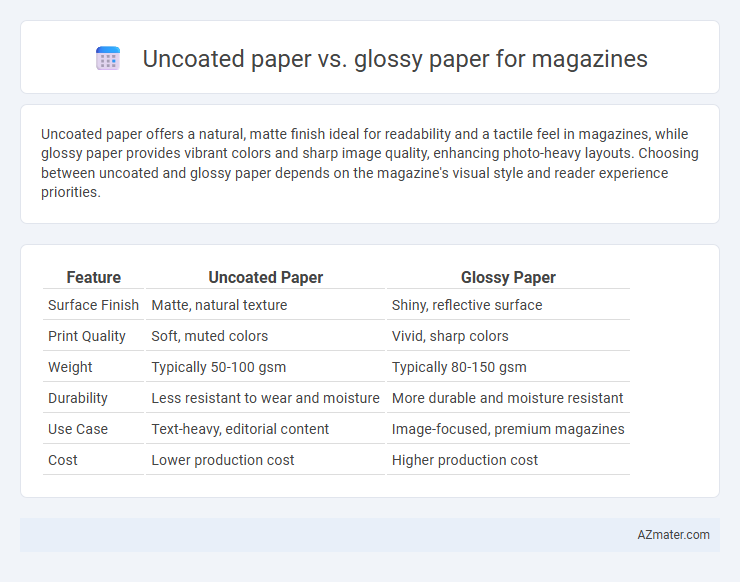Uncoated paper offers a natural, matte finish ideal for readability and a tactile feel in magazines, while glossy paper provides vibrant colors and sharp image quality, enhancing photo-heavy layouts. Choosing between uncoated and glossy paper depends on the magazine's visual style and reader experience priorities.
Table of Comparison
| Feature | Uncoated Paper | Glossy Paper |
|---|---|---|
| Surface Finish | Matte, natural texture | Shiny, reflective surface |
| Print Quality | Soft, muted colors | Vivid, sharp colors |
| Weight | Typically 50-100 gsm | Typically 80-150 gsm |
| Durability | Less resistant to wear and moisture | More durable and moisture resistant |
| Use Case | Text-heavy, editorial content | Image-focused, premium magazines |
| Cost | Lower production cost | Higher production cost |
Introduction to Magazine Paper Types
Magazine paper types primarily include uncoated and glossy varieties, each offering distinct print qualities and tactile experiences. Uncoated paper provides a matte finish with natural texture, enhancing readability and a soft, elegant feel often favored for literary or art magazines. Glossy paper features a shiny surface that intensifies colors and sharpness, making it ideal for high-impact visuals and vibrant photography in fashion or lifestyle magazines.
What is Uncoated Paper?
Uncoated paper is a type of paper that lacks a glossy or shiny finish, resulting in a natural, matte texture that absorbs ink more readily, ideal for magazines emphasizing readability and a tactile experience. It is made from cellulose fibers without additional coatings, enhancing ink penetration and reducing glare, which benefits magazines aiming for a sophisticated, understated aesthetic. Compared to glossy paper, uncoated paper offers better writeability and a more organic look, making it suitable for editorial content and photography that requires a soft, muted appearance.
What is Glossy Paper?
Glossy paper is a coated paper type featuring a smooth, shiny surface that enhances color vibrancy and sharpness, making it ideal for magazines with high-quality images and photo spreads. Its reflective finish improves visual appeal and contrast, providing a polished, professional look that attracts readers. Compared to uncoated paper, glossy paper offers superior ink retention and durability, ensuring the magazine's content remains vivid and smudge-resistant.
Visual Appeal: Uncoated vs Glossy
Uncoated paper offers a natural, matte finish that enhances readability and provides a soft, tactile feel, making images appear more subdued and text easier on the eyes. Glossy paper delivers high contrast and vibrant colors with a reflective sheen, making photographs and graphics pop with sharp detail and vivid intensity. For magazines, choosing glossy paper maximizes visual impact and color saturation, while uncoated paper supports a more understated, elegant aesthetic.
Print Quality and Color Reproduction
Uncoated paper provides a natural, matte finish that enhances readability with less glare, offering muted and softer color tones ideal for text-heavy magazines focused on editorial quality. Glossy paper delivers high print quality with vibrant and sharp color reproduction, making images and graphics stand out through its smooth, reflective surface that intensifies contrast and saturation. Choosing between uncoated and glossy paper depends on balancing the desired visual impact with tactile experience, where uncoated favors subtlety and readability, while glossy emphasizes vivid imagery and dynamic presentation.
Texture and Tactile Experience
Uncoated paper offers a natural, matte finish with a slightly rough texture that enhances the tactile experience through its absorbent surface, making it ideal for magazines emphasizing a more organic and sophisticated feel. Glossy paper features a smooth, reflective coating that provides a sleek touch and vibrant color reproduction, creating a visually striking yet less textured experience. The choice between uncoated and glossy paper significantly affects reader interaction, with uncoated paper promoting a warm, tactile connection and glossy paper delivering a polished, high-gloss sensation.
Durability and Resistance to Wear
Uncoated paper offers moderate durability with a matte finish that resists fingerprints but is more prone to scuffing and staining from frequent handling in magazines. Glossy paper provides superior resistance to wear due to its coated surface, which protects against moisture, dirt, and abrasion, ensuring vibrant images and text remain intact during extended use. For magazines requiring long-lasting visual appeal and frequent reader interaction, glossy paper is often the preferred choice for enhanced durability.
Environmental and Sustainability Factors
Uncoated paper for magazines offers a more sustainable option due to its lower energy consumption during production and easier recyclability compared to glossy paper, which involves additional chemical coatings and processes that increase environmental impact. The lack of plastic or mineral oil-based coatings on uncoated paper reduces pollution and improves biodegradability, making it a preferred choice for eco-conscious publishers. Glossy paper, while visually appealing, often hinders recycling efforts and contributes to landfill waste, challenging sustainability objectives.
Cost Differences: Uncoated vs Glossy Paper
Uncoated paper generally costs less than glossy paper due to its simpler production process and lower material requirements. Glossy paper involves additional coating layers that increase manufacturing expenses, resulting in higher per-unit costs for magazines. Publishers aiming to manage budget constraints often choose uncoated paper to reduce printing costs while maintaining acceptable quality.
Choosing the Right Paper for Your Magazine
Uncoated paper offers a natural, matte finish that enhances readability and provides an organic feel, making it ideal for magazines focused on text-heavy content or an artisanal aesthetic. Glossy paper delivers vibrant colors and sharp images, perfect for magazines with high-quality photography and visual appeal, commonly used in fashion and lifestyle publications. Selecting between uncoated and glossy paper depends on your magazine's content style, target audience, and desired visual impact to achieve optimal reader engagement and brand identity.

Infographic: Uncoated paper vs Glossy paper for Magazine
 azmater.com
azmater.com